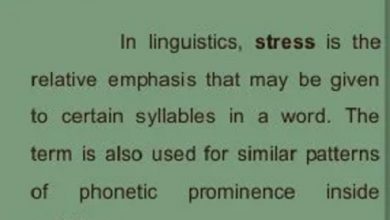Coarticulation definition of consonants and vowel sounds
Coarticulation
Coarticulation (from Lat. Co (n) “with, together” + articulatio “articulate, clearly articulate”) is the imposition of articulation characteristic of the subsequent sound on the entire previous sound. An example of coarticulation is the labialization of a consonant under the influence of the subsequent labial or in Russian: volume – there; fat – so. Sometimes coarticulation is contrasted with accommodation as a complete overlay of articulation to a partial one, but often these terms are used interchangeably. In this article, we will describe the Coarticulation of consonants and vowels with an explanation. Lets see what is the Coarticulation definition
Coarticulation generally refers to a situation in which a conceptually isolated speech sound is influenced by and becomes more like a preceding or subsequent speech sound. There are two types of coarticulation: anticipatory coarticulation, when a feature or characteristic of a speech sound is expected (assumed) during the reproduction of a prior speech sound; and transference or perseverative coarticulation, where the effects of sound are seen during the production of the sound (s) that follow. Many models have been developed to account for coarticulation. These include models for prediction, articulatory syllable, timing, windowing, co-play, and articulatory phonology.
Coarticulation in phonetics refers to two distinct phenomena.
assimilation in the place of articulation of one speech sound into that of the neighboring speech sound. For example, while the sound / n / in English usually has an alveolar articulation site, in tenth it is pronounced along with the dental articulation site, because the next sound, / θ /, is dental.
the production of a jointly articulated consonant, that is, a consonant with two simultaneous places of articulation. An example of such a sound is the voiceless labial velar plosive / k͡p / found in many West African languages.
The term coarticulation can also refer to the transition from one articulatory gesture to another.
Coarticulation of consonants and vowels
Vowel and consonant coarticulation interactions are also possible.
1-Coarticulation by the way of noise formation.
The alveolar plosive [t] in the intervocalic position in front of the unstressed vowel, as in pretty, writer, is replaced by a tap consonant articulated by the tip of the tongue that touches the alveoli for a very short time. This tendency is observed only in the position in front of unstressed vowels. In the stressed position, as in the word pretend, the sound [t] remains deaf explosive. The same sound is pronounced instead of [d] and [n] in similar contexts: ladder, sunny (in this word it is also nasalized). This trend is more common in American English than in British.
2-Coarticulation by the position of the soft palate.
Vowels are nasalized under the influence of neighboring nasal consonants: nice, mean. In the morning, all vowels get nasal coloration, as they are in the vicinity of nasal consonants, so when pronouncing the whole word, the soft palate is lowered, allowing the air stream to escape through the oral cavity and partially through the nasal cavity.
This phenomenon is widespread in various languages, and its nature is due to purely physiological reasons. However, in languages where nasal and non-nasal consonants are opposed, as in French, nasalization of vowels in the vicinity of nasal consonants is not observed.
3-Coarticulation by lip position.
The consonants are rounded under the influence of labialized vowels: pot, root. This effect is most noticeable, for example, in the word see-saw, where the sound [s] before the vowel [i:] is pronounced with stretched lips, and before the vowel with rounded. The degree of consonant labialization depends on the nature of the vowel, and the type of consonant labialized does not matter.
This trend can be observed in many other languages, where there is no opposition between labialized and non-labialized consonants.
4-Coarticulation at the place of education.
Velar [k], [g] become more advanced when combined with subsequent front vowels. Since, to pronounce these vowels, the entire body of the language moves forward and this articulatory gesture begins during the formation of the plosive bow: kea, kit, kept, cat, geese, give, get, gap.
The vowel before [l], such as in peal, bell, result, becomes more open and drawn.
The vowel [u] combined with [j] becomes much more advanced: use, pew, tune.
5-Coarticulation according to the work of the vocal cords.
The voiceless fricative [h] is voiced in the inter vocal position, as in a phrase like behind the house.
6-Coarticulation at the place of formation of a secondary obstruction
On the main articulation of a consonant sound, an additional rise of the front of the tongue to the hard palate can be superimposed, forming a secondary obstruction. This phenomenon is called palatalization. It gives the consonant [and] -shaped sound. This is how soft consonants are formed in Russian. Palatalization is widespread in Slavic languages, but it is not typical for English. However, in the position in front of the closed front vowels, which are formed when the front of the tongue is raised high, the consonants can be slightly palatalized. So, for example, in the words seat, sit the sound [s] sounds somewhat softer than in the words sort, soot.
A special case is the combination of the sound [l] with vowels and the approximant [j]. Most speakers of normative British pronunciation use the palatalized, so-called clear shade of the sound [l], as in the words lie, leak, law, low, or the combination will you.
A secondary obstruction, as a rule, is formed during the articulation of the sound [l], when it is used at the end of a word or before another consonant, for example: fill, pale, belt. In such cases, the back of the tongue rises to the soft palate, giving the sound an [l] [y] -shaped or [s] -shaped sound. This phenomenon is called velarization. This shade of sound [l] is called dark.
